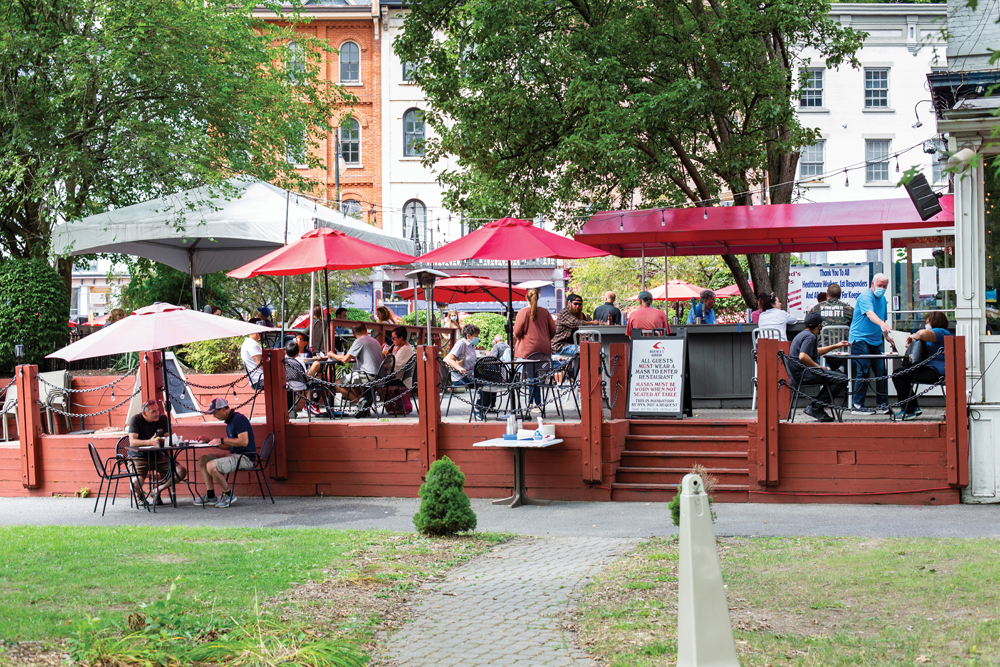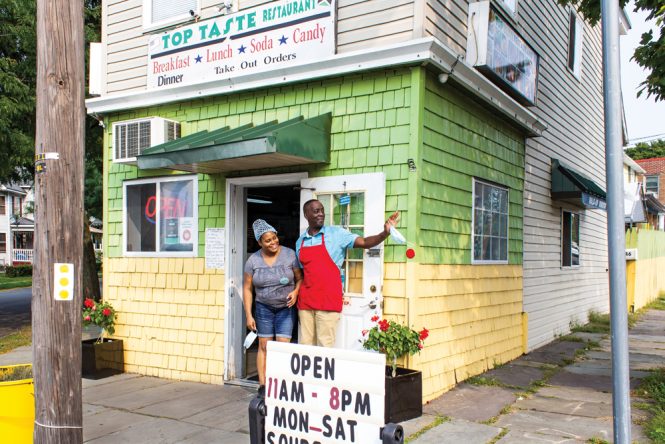Kingston: Hottest Hot Spot
By Anne Pyburn Craig | Photos by Anna Sirota | Fall 2021 | Community Spotlight
Kingston’s a place where many divergent forces come together, starting with the Catskills, the Rondout Creek, and the mighty Hudson. The Dutch established a trading post here in 1614, trading with the locals and (no doubt unwittingly) positioning the city perfectly for a lot of drama that followed.
Forty years later, Europeans introduced the notion of buying and selling land, and trouble erupted. Tensions over trade and land use grew and New Amsterdam Director-General Peter Stuyvesant commanded a move up the hill and inland and built a fort, and the big fences did not make better neighbors. The bloody Esopus Wars that followed the building of the Stockade lasted until 1663, when the Dutch declared victory.
The fortified zone was renamed Kingston when the Brits took over. In 1777, Kingston was deemed the safest spot for the capital of the emerging state of New York, and so the state’s constitution and early governance emerged from a public house within the Stockade, which British forces attacked and burned later that year. Buildings and wheat were destroyed, but the humans survived to rebuild.
In the 1820s, the D&H Canal transformed the Rondout settlement into a bustling port, moving tons of coal, cement, bricks, bluestone, and ice. You can still find chunks of Kingston-made brick mixed with the sand of Kingston Point Beach; uptown, traces of the outline of the fortification remain along with a wealth of preserved stone buildings.
Over many decades, the area between the Stockade and the Rondout port grew into a neighborhood full of factories, schools, and hospitals amid low-slung narrow streets of mostly Victorian-style homes. Kingston spent 40 years of the 20th century as an IBM town, and when the company left in the early ’90s, the city’s economy took a body blow. Gradually, art and hospitality and indie commerce have arisen to fill the void. In today’s Kingston, factories have been repurposed as housing and studio space for creatives, and facades are seasoned with gorgeous murals from the innovative O+ Festival. Where dock workers once toiled there are restaurants and tour boats— including the Solaris, a 100 percent-solar-powered vessel created right here at the Hudson River Maritime Museum.
The Scene
Artist Anne Sanger found her dream house in Hurley and moved north from Brooklyn in 2018; in 2019, the corporate-world refugee opened Pinkwater Gallery on North Front Street. “I just felt like Kingston had so much to offer, and I’m loving it,” she says. “Best decision I ever made besides getting my dog.”
She’s found loads to eat within walking distance. “Le Canard Enchaine is just like being in Paris,” she says. “Boitson’s is my favorite place for a martini, and the Stockade Tavern is always great. For lunch I love Board and Lola Pizza. Then there’s Rough Draft Bar and Books, kinda the gold standard in my world.”

Top Taste Caribbean restaurant in Midtown Kingston
Sanger loves the curation and finds at Upstate Capital Market and Lovefield Vintage. “Then for dressy stuff, there’s River Mint Finery for gorgeous designer things. I also love the Conscious Co. Boutique,” she says. “And North Front Gallery has wonderfully inspiring high-end artwork.”
Midtown, where revitalization lagged as the Stockade and Rondout neighborhoods rose, has become the city’s preeminent arts district, a natural consequence of the conversions of the Lace Mill and three former factories into artist-friendly housing and studio space, and a plethora of new eateries there have joined stalwarts like Frank Guido’s Little Italy and Monkey Joe Roasting Company; community- forward establishments like Seasoned Delicious Foods and Tilda’s Kitchen and Market bring globally inspired and locally crafted fare to the table. The Ulster Performing Arts Center has a relatively new neighbor in Energy Square, a deep-green mixed-income apartment building that’s also home to the Center for Creative Education.
Down the hill by the Rondout you’ll find more art, food, and fun, including the Hudson River Maritime Museum and Kingston Trolley Museum, in addition to luxury cabin lodging and dining on the river at Hutton Brickyards.
The Kingston Real Estate Market
“Kingston’s on a roll,” says Hayes Clement, a realtor with Berkshire Hathaway Home Services. “It was a seller’s market even before COVID, and now it’s on fire. My advice would be to come prepared to make an aggressive offer and have your ducks in a row as far as financing. And if you buy something that needs work, be prepared for a bit of a wait to get a contractor— depending on the scale of the reno, you might wait six months to a year.”
Move-in-ready homes are being snapped up almost overnight. “They’re at a premium,” says Clement. “We’re seeing six figures over the asking price on ones that are done-done- done. Overall, inventory is low given the level of demand. There may be a few more properties this fall, but still not enough, really. Four or five years ago, $500,000 for a house in Kingston was unusual; now it’s commonplace, and we’re starting to get into the 800s.”
At press time, there were a few foreclosures and fixer-uppers and some building sites priced at under $200,000. Between there
and $450,000, there were some three- and four-bedroom midtown Colonials and a few ranch-style homes on the outskirts. Between $400,000 and $600,000, one begins to encounter architecturally significant homes in better shape, on larger lots. A pristine Queen Anne Victorian in the Rondout district, priced at $834,900, features four bedrooms with gobs of original oak and cherry, stained glass, original moldings, and a balcony along with fully modernized kitchen and a wine cave.
And for $1,190,000 (or somewhere near it), someone will become the proud owner of a five-bedroom tastefully constructed palace on 9.5 acres atop a hill, featuring a gourmet chef’s kitchen, 1,000 square foot entertainment and fitness space, and in-ground pool.
